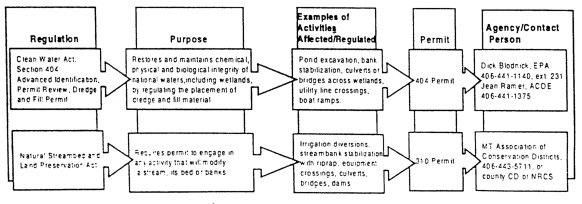|
July/August/September 1999 |
Page
4 |
Maintaining Unpaved Roads Near Lakes
Streams and Wetlands
|
| Erosion from exposed or disturbed soils averages 151 tons per acre per
year, about 76 tons of which are transported from the watershed. This is about 10 times that normally expected from cultivated land, 200 times that from
grassland, and 2,000 times that from forest land. Erosion from disturbed soils can be catastrophic for the watersheds, equaling erosion which would occur during 40 years of soil
cultivation, 800 years under grass, and 8,000 years under forest. Vegetative cover plays an extremely important role in
controlling |
Any existing vegetation which can be saved will help prevent erosion. Trees and other vegetation protect the soil as well as beautifying the site after construction. Obviously, once plant growth is established on road shoulders, it should be disturbed only when absolutely necessary. Minimize road maintenance 100 feet before and after live stream crossings to reduce sedimentation. In some cases, road stabilization and compaction may also be used. |

erosion in the
following five ways:
-
shields the soil surface from the impact of
falling rain:
-
holds soil particles in place;
-
maintains the soilís capacity to absorb water;
-
slows the velocity of runoff; and
-
removes subsurface water between rainfalls through the process of
evapotranspiration.
|
By limiting and staging the removal of existing vegetation, and by decreasing the area and duration of exposure, soil erosion and sedimentation can be significantly reduced. Special consideration should be given to the maintenance of existing vegetative cover on areas of high erosion potential such as erodible soils, steep slopes. drainageways. and the banks of
streams
Avoid disrupting
vegetation
on road
shoulders near lakes, streams and marshes. As noted above, ground cover is the most important factor in terms of preventing erosion. |
Avoid grading excess material
off
road shoulders whenever possible. Shoulders are the most important roadway area from the standpoint of erosion to the roadbed. Shoulder erosion quickly exposes road core material and exposes the roadbed. This erosion weakens the shoulder and pavement surface and presents a hazard to vehicles that must leave the surfaced area.
Gravel filter berms can be an effective means of controlling erosion and sediment caused on road shoulders by sheet erosion. Construction of a gravel filter berm is accomplished by grading a berm onto the toe of the shoulder. Gravel must be sufficiently coarse to allow water to seep through the berm without dislodging the
gravel. Care should be exercised to make sure that the berm does not have the unintended effect of channeling water flow and causing even greater flows
and resulting erosion. Construct gravel filter berms on
road
shoulders closest to lakes, streams or marshes. |
|